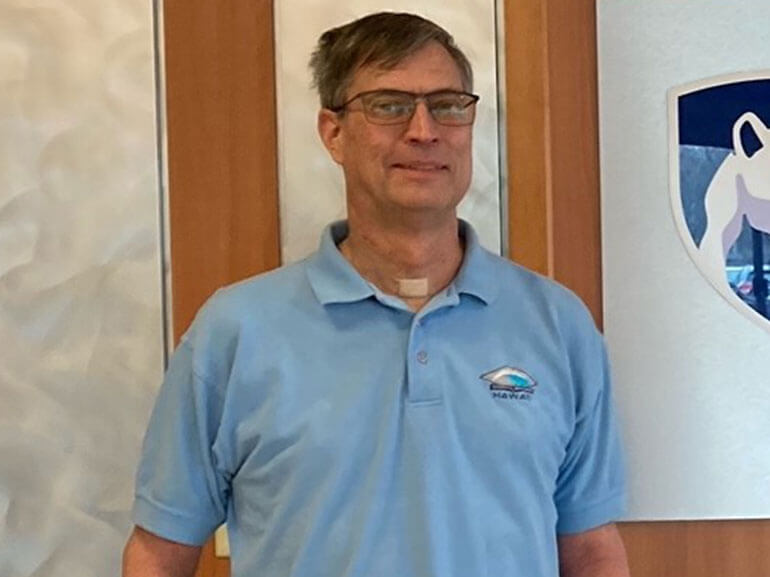Timothy's story

Timothy “Tim” Anger is a high school teacher and the principal at Emmaus Baptist Academy, a small Christian school in the Lehigh Valley, PA, where he has served for more than 30 years. He is also very involved in his church, including running the Children’s Ministries and playing the organ. He has five children and nine grandchildren.
On an otherwise ordinary morning, Tim drove to a board meeting for the Keystone Christian Education Association in Harrisburg. He was feeling fine and had no idea the dramatic turn his day – and life – would take.
Halfway through the morning meeting, Tim suddenly began to feel tired and then collapsed onto the floor. His fellow board members quickly called 911 and thought he was having a stroke. The ambulance arrived and took Tim to the emergency room at Penn State Hershey Medical Center. Physicians there determined that Tim was experiencing an aortic dissection type A – a sudden heart condition where the large artery that leads from the heart to the brain and the rest of the body ruptures. This rare heart condition is often fatal, with only about three percent of victims surviving. As he was being rushed to the operating room, Tim went into full cardiac arrest for three minutes. Doctors said that if it had lasted any longer, he would have likely suffered life-long neurological damage.
Tim says that he is convinced God orchestrated these events to unfold at one of the premier heart hospitals in the region where expert surgeons and doctors were skilled to quickly deal with the emergency.
Tim was on full life support with an open chest for days after the life-saving surgery. For almost two weeks, he was kept in a medically induced coma while family members traveled in, wondering if they would be saying final goodbyes or seeing any signs of progress. On day nine of the vigil, Tim opened his eyes and recognized the voice of his wife as she sang him comforting hymns.
While Tim had turned the corner, his recovery in the intensive care unit continued for weeks until he was moved to the progressive care unit at Penn State Hershey Medical Center. Open heart surgery, followed by weeks of being bed-ridden had left Tim with muscle atrophy, weakness, deconditioning and the need to learn to walk again and to carry on daily living tasks. Tim’s physicians recommended that he transfer to Penn State Health Rehabilitation Hospital for the next step in his recovery.
Upon admission, Tim was only able to take approximately 12-15 steps. He was nervous about going to rehabilitation and leaving the doctors and care team he trusted. However, they highly recommended Penn State Health Rehabilitation Hospital for the care he would receive there. The fact that Tim’s trusted medical team was located close by also provided him with reassurance. After an assessment by the physician-led team of nurses, physical, occupational and speech therapists at Penn State Health Rehabilitation Hospital was complete, Tim was ready to get to work.
In physical therapy, Tim’s therapists focused on increasing his walking ability, strengthening his muscles, honing his balance and building confidence to safely return home. Tim also engaged in a variety of occupational therapy treatments focusing on fine motor manipulation and standing tolerance and balance as well as upper extremity and upper body strengthening. Some of the occupational therapy activities Tim’s therapists utilized were playing the piano, simulating home activities and transferring from laying to sitting to standing.
When Tim arrived at Penn State Health Rehabilitation Hospital, he was unable to eat normally. His speech therapy focused on swallowing skills and exercises so that he could safely return to a more regular diet with thin liquids and some of his favorite foods. During his therapy sessions, Tim’s wife Donna was very engaged in learning how and when to provide her husband with assistance. By the end of his stay, Tim was able to walk longer distances with just the assistance of a cane.
Tim is grateful for the help of the many health professionals who saved his life and helped him improve to the point where he was able to return home exactly two months after the incident. He also had a strong support system of family, friends and church family who were praying for him regularly.
“The nursing staff took good care of my needs, like monitoring wounds and giving me my medications,” Tim said. He also enjoyed the meals at the hospital, especially when he was able to move from pureed to chopped foods and then to regular food. Tim also stated, “I was very impressed with the way the resident doctor, speech therapist, physical therapist and occupational therapist worked hard to understand my unique situation and tailor the treatments to help me reach my goals.”
When Tim and Donna reflected on their journey, Donna said she felt an “a-ha” moment when she was watching Tim in the therapy gym and noticed Tim’s physical therapist providing less hands-on assistance when walking. She felt this was a turning point and felt more assured about Tim coming home and her ability to care for him. Donna added, “Tim’s therapist was calming and had a way of pushing Tim just enough to keep progressing at the right pace.”
Another pivotal moment that Donna recalls was when the occupational therapist had her assist Tim with a shower with the therapist’s guidance and supervision, providing important education and advice. Donna felt this was very beneficial and made her feel better about Tim’s transition home.
Tim’s most immediate goals upon discharge from Penn State Health Rehabilitation Hospital were to return to his job by the end of the school year and to attend high school graduation. When asked what he most looked forward to, Tim responded, “Getting my favorite coffee at Dunkin Donuts and attending the family meals we host at our home with the entire family.”